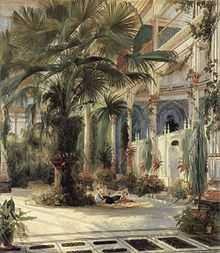Carl Blechen

Carl Blechen (July 29, 1798 – July 23, 1840), sometimes given as Karl Blechen, was a German painter who specialized in fantastic landscapes, sometimes with demons and grotesque figures. Later in his career, Blechen turned to depicting contemporary subjects with an increasingly naturalistic technique, sometimes painting directly in nature. With his Iron-rolling Mill (c. 1830) and Gorge near Amalfi (1831), Blechen became one of the first European painters to represent early industrialization in the landscape.[1] Belonging to the generation of artists after Caspar David Friedrich and a forerunner to realists like the fellow Berliner Adolph Menzel, he is often cited as an artist "between Romanticism and Realism."[2]
Born in Cottbus, he drew the attention of prominent architect Karl Friedrich Schinkel, who cast him as a decorative painter. Blechen however aimed for higher work and began producing landscape paintings. In 1829 he went to Italy, and from 1835 was a member and professor at the Akademie der Künste in Berlin.
Gallery
-

Im Berliner Tiergarten, 1825
-

Der gesprengte Turm des Heidelberger Schlosses (The Ruined Tower of Heidelberg Castle), 1830
-
Bau der Teufelsbrücke, 1830–32
-

Badende im Park von Terni, 1829
-

Gorge near Amalfi (Schlucht bei Amalfi, 1831
-

Im Park der Villa d'Este, 1830
-

Palm House on the Pfaueninsel (Peacock Island) near Potsdam, 1832-1834
-
.jpg)
View on Assisi 1832-35
See also
References
| Wikimedia Commons has media related to Carl Blechen. |
- (German) "Blechen". Meyers Konversations-Lexikon 3 (4th ed.). 1890. p. 11.
- Founder of the German realistic plein air landscape
- ↑ Berger, Karl. Karl Blechen, Leipzig: E.A. Seemann Verlag, 1965. Hilger, Hans-Peter. “Anfänge der Industriemalerei in Deutschland” Der Anschnitt. Vol 12 S. 10-14, 1960. Vignau-Wilberg, Peter. "Das ‚Walzwerk in Eberswalde’ von Carl Blechen und die frühe Industriedarstellung,“in Carl Blechen (1798 - 1840): Grenzerfahrungen - Grenzüberschreitungen, Vogel, Gerd-Helge and Barbara Baumüller, eds.. Greifswald: Steinbecker Verlag, 2000.
- ↑ Peter-Klaus Schuster, Carl Blechen: Zwischen Romantik und Realismus, Munich: Prestel, 1990.
External links
- German masters of the nineteenth century : paintings and drawings from the Federal Republic of Germany, a full text exhibition catalog from The Metropolitan Museum of Art, which contains material on Carl Blechen (no. 1-4)
|
